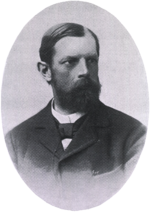|
Hans Ernst August Buchner
Hans Ernst August Buchner (16 December 1850 – 5 April 1902) was a German bacteriologist who was born and raised in Munich. He was the older brother of Eduard Buchner (1860–1917), winner of the 1907 Nobel Prize in Chemistry. BiographyHe studied medicine in Munich and Leipzig, earning his MD from the University of Leipzig in 1874. Afterwards he served as a physician in the Bavarian Army. In 1880 he became a lecturer at the University of Munich, where in 1894 he succeeded Max von Pettenkofer (1818–1901) as professor and director of the institute of hygiene.[1] At Munich, he was an associate of Max von Gruber (1853–1927). Hans Buchner was a pioneer in the field of immunology. He was the first to discover a substance in blood serum that was capable of destroying bacteria. He called the substance "alexin", which was later named "complement" by Paul Ehrlich (1854–1915).[1] In 1888 he introduced the pyrogallic method for cultivation of anaerobic bacteria.[2][3] Along with Martin Hahn, he assisted his brother, Eduard Buchner, with the isolation of zymase. Their findings were published in a 1903 treatise titled "Die Zymasegärung" (Zymase fermentation).[4] Selected writings
References
External links
|
||||||||||||||||
